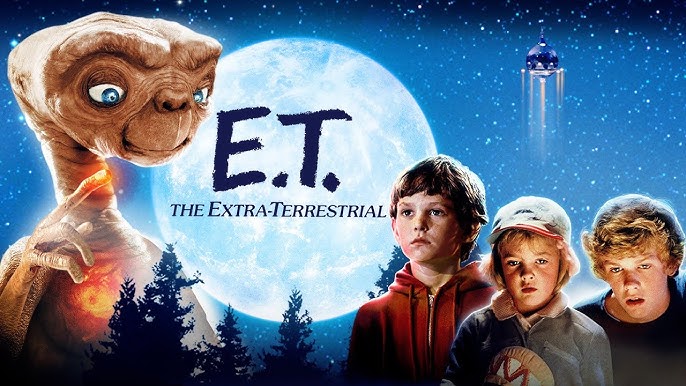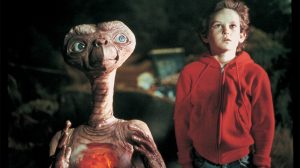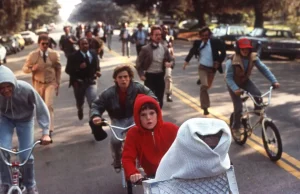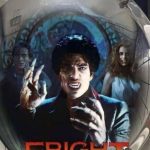“ET the Extra-Terrestrial (1982) “
- movieslovers
- November 10, 2024

“E.T. the Extra-Terrestrial” (1982) is a heartwarming science fiction film directed by Steven Spielberg, telling the story of a young boy named Elliott (Henry Thomas) who befriends an alien left behind on Earth. Widely regarded as one of Spielberg’s most iconic films, E.T. beautifully blends themes of friendship, empathy, and wonder, becoming a beloved classic that has touched audiences for generations.
Plot Summary
The film begins with a gentle alien being stranded on Earth when his spaceship departs without him. The alien, later named E.T., hides in a California suburb, where he is discovered by 10-year-old Elliott. Although initially frightened, Elliott quickly befriends E.T. and brings him into his home, where he hides the alien from his mother and introduces him to his siblings, Michael (Robert MacNaughton) and Gertie (Drew Barrymore).
As they grow closer, Elliott realizes that E.T. is desperately trying to “phone home” to reunite with his family. He and his siblings help E.T. build a communication device out of everyday objects. Over time, a special bond forms between Elliott and E.T., to the point where they begin to feel each other’s emotions and physical sensations. However, E.T.’s health deteriorates as he remains on Earth, and soon government agents discover their secret, leading to a climactic race to get E.T. safely back to his spaceship.
The story culminates in a tearful farewell as E.T. bids goodbye to Elliott, touching his forehead and saying, “I’ll be right here.” The two part ways, and E.T. returns to his home planet, leaving Elliott forever changed.
Key Themes
- Friendship and Empathy: The bond between Elliott and E.T. is the heart of the film, showcasing a friendship that transcends species and speaks to the universal power of empathy.
- Childhood Wonder and Innocence: Spielberg captures the innocence and curiosity of childhood, portraying the magical feeling of discovering something extraordinary. Elliott’s experience with E.T. is symbolic of the boundless imagination and acceptance children possess.
- Family and Connection: The film also delves into themes of family and loneliness, as Elliott and E.T. both feel isolated in their own ways. Through their friendship, they find a sense of belonging and connection.
- Alienation and Acceptance: E.T., as a stranger on Earth, represents the fear of being misunderstood or judged, yet he finds acceptance in Elliott, who sees beyond their differences and welcomes him unconditionally.
Iconic Scenes and Moments
- Flying Bicycle Scene: One of the film’s most iconic moments occurs when E.T. uses his telekinetic abilities to lift Elliott’s bike into the sky, silhouetted against the full moon—a scene that became the logo for Spielberg’s production company, Amblin Entertainment.
- E.T. and Elliott’s Bond: As E.T. and Elliott share a psychic connection, moments like Elliott’s classroom experience where he feels E.T.’s emotions showcase the depth of their bond.
- “E.T. Phone Home”: The phrase “E.T. phone home” has become iconic, symbolizing E.T.’s yearning to return to his family and the emotional pull of home for all beings.
- Emotional Farewell: The film’s final scene, where E.T. touches Elliott’s forehead and says, “I’ll be right here,” is a deeply emotional moment that leaves a lasting impact.

Performances
- Henry Thomas as Elliott gives a remarkable performance, portraying his character’s innocence, curiosity, and love for E.T. in a way that resonates deeply with audiences.
- Drew Barrymore as Gertie provides warmth and comic relief, capturing the honesty of a young child’s emotions in her interactions with E.T.
- The puppetry and animatronics used to bring E.T. to life were groundbreaking for the time, with E.T. portrayed as expressive and lifelike, adding to the believability of his character and making the audience root for him.
Cinematography and Special Effects
The film’s cinematography, by Allen Daviau, and its special effects were revolutionary for their time, with the use of practical effects, lighting, and puppetry to bring E.T. to life. The lighting, especially during scenes in the forest and around E.T., gives a magical quality to the visuals, emphasizing wonder and mystery. The practical effects work well to make E.T. feel authentic, enhancing the audience’s emotional connection to him.
Music
John Williams’ musical score is one of the film’s defining elements, capturing the awe, joy, and emotional intensity of the story. The soaring theme during the bike flight scene is particularly famous, encapsulating the film’s spirit of adventure and the magic of friendship. The soundtrack contributes significantly to the film’s emotional weight and lasting legacy.
Reception and Legacy
E.T. the Extra-Terrestrial was a box office phenomenon, becoming the highest-grossing film of its time and receiving widespread critical acclaim. It earned multiple Academy Award nominations, including Best Picture, and won awards for Best Original Score, Best Sound, Best Sound Effects Editing, and Best Visual Effects.
Its legacy endures as one of the greatest family films ever made, celebrated for its emotional depth, universal themes, and groundbreaking approach to storytelling. E.T. became a cultural icon, and its impact is evident in the film’s continuing influence on the science fiction genre and family cinema.
Cast and Crew
- Director: Steven Spielberg
- Writer: Melissa Mathison
- Cast:
- Henry Thomas as Elliott
- Drew Barrymore as Gertie
- Robert MacNaughton as Michael
- Dee Wallace as Mary (Elliott’s mother)
- Peter Coyote as Keys, the government agent
- Pat Welsh as the voice of E.T.
Fun Facts
- Henry Thomas’s audition for Elliott moved Spielberg to tears, securing him the role instantly.
- The design for E.T. was inspired by Albert Einstein, Carl Sandburg, and a pug dog, giving him a unique, empathetic appearance.
- Drew Barrymore was only six years old during filming, and Spielberg used her innocence to bring natural warmth and authenticity to her character.
- E.T. was initially imagined as a darker film about alien invasion, but Spielberg re-envisioned it as a family-friendly story of friendship.
Conclusion
E.T. the Extra-Terrestrial is a timeless story about the power of friendship and the beauty of human connection, bridging the gap between childhood innocence and the complexities of life. With its memorable performances, innovative effects, and heartwarming message, E.T. remains a cinematic masterpiece that continues to captivate audiences young and old. It’s a reminder of the magic of childhood, the importance of acceptance, and the joy of finding friendship in the most unexpected places.











